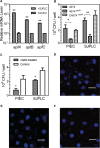Adhesion protein ApfA of Actinobacillus pleuropneumoniae is required for pathogenesis and is a potential target for vaccine development
- PMID: 23269417
- PMCID: PMC3571269
- DOI: 10.1128/CVI.00616-12
Adhesion protein ApfA of Actinobacillus pleuropneumoniae is required for pathogenesis and is a potential target for vaccine development
Abstract
Actinobacillus pleuropneumoniae is the etiologic agent of porcine pleuropneumonia, which causes serious economic losses in the pig farming industry worldwide. Due to a lack of knowledge of its virulence factors and a lack of effective vaccines able to confer cross-serotype protection, it is difficult to place this disease under control. By analyzing its genome sequences, we found that type IV fimbrial subunit protein ApfA is highly conserved among different serotypes of A. pleuropneumoniae. Our study shows that ApfA is an adhesin since its expression was greatly upregulated (135-fold) upon contact with host cells, while its deletion mutant attenuated its capability of adhesion. The inactivation of apfA dramatically reduced the ability of A. pleuropneumoniae to colonize mouse lung, suggesting that apfA is a virulence factor. Purified recombinant ApfA elicited an elevated humoral immune response and conferred robust protection against challenges with A. pleuropneumoniae serovar 1 strain 4074 and serovar 7 strain WF83 in mice. Importantly, the anti-ApfA serum conferred significant protection against both serovar 1 and serovar 7 in mice. These studies indicate that ApfA promotes virulence through attachment to host cells, and its immunogenicity renders it a promising novel subunit vaccine candidate against infection with A. pleuropneumoniae.
Figures





Similar articles
-
Type IV fimbrial subunit protein ApfA contributes to protection against porcine pleuropneumonia.Vet Res. 2012 Jan 12;43(1):2. doi: 10.1186/1297-9716-43-2. Vet Res. 2012. PMID: 22240397 Free PMC article. Clinical Trial.
-
DNA vaccine encoding type IV pilin of Actinobacillus pleuropneumoniae induces strong immune response but confers limited protective efficacy against serotype 2 challenge.Vaccine. 2011 Oct 13;29(44):7740-6. doi: 10.1016/j.vaccine.2011.07.127. Epub 2011 Aug 9. Vaccine. 2011. PMID: 21835218
-
Identification and characterization of serovar-independent immunogens in Actinobacillus pleuropneumoniae.Vet Res. 2017 Nov 9;48(1):74. doi: 10.1186/s13567-017-0479-5. Vet Res. 2017. PMID: 29122004 Free PMC article.
-
New trends in innovative vaccine development against Actinobacillus pleuropneumoniae.Vet Microbiol. 2018 Apr;217:66-75. doi: 10.1016/j.vetmic.2018.02.028. Epub 2018 Mar 6. Vet Microbiol. 2018. PMID: 29615259 Review.
-
Actinobacillus pleuropneumoniae surface polysaccharides: their role in diagnosis and immunogenicity.Anim Health Res Rev. 2000 Dec;1(2):73-93. doi: 10.1017/s1466252300000074. Anim Health Res Rev. 2000. PMID: 11708600 Review.
Cited by
-
In vivo testing of novel vaccine prototypes against Actinobacillus pleuropneumoniae.Vet Res. 2018 Jan 9;49(1):4. doi: 10.1186/s13567-017-0502-x. Vet Res. 2018. PMID: 29316978 Free PMC article.
-
Actinobacillus pleuropneumoniae, surface proteins and virulence: a review.Front Vet Sci. 2023 Nov 30;10:1276712. doi: 10.3389/fvets.2023.1276712. eCollection 2023. Front Vet Sci. 2023. PMID: 38098987 Free PMC article. Review.
-
Identification of FtpA, a Dps-Like Protein Involved in Anti-Oxidative Stress and Virulence in Actinobacillus pleuropneumoniae.J Bacteriol. 2022 Feb 15;204(2):e0032621. doi: 10.1128/JB.00326-21. Epub 2021 Nov 22. J Bacteriol. 2022. PMID: 34807725 Free PMC article.
-
Role of (p)ppGpp in Viability and Biofilm Formation of Actinobacillus pleuropneumoniae S8.PLoS One. 2015 Oct 28;10(10):e0141501. doi: 10.1371/journal.pone.0141501. eCollection 2015. PLoS One. 2015. PMID: 26509499 Free PMC article.
-
Identification and characterization of a novel stress-responsive outer membrane protein Lip40 from Actinobacillus pleuropneumoniae.BMC Biotechnol. 2015 Nov 25;15:106. doi: 10.1186/s12896-015-0199-8. BMC Biotechnol. 2015. PMID: 26608465 Free PMC article.
References
-
- Bossé JT, Janson H, Sheehan BJ, Beddek AJ, Rycroft AN, Kroll JS, Langford PR. 2002. Actinobacillus pleuropneumoniae: pathobiology and pathogenesis of infection. Microb. Infect. 4:225–235 - PubMed
-
- Ramjeet M, Deslandes V, Goure J, Jacques M. 2008. Actinobacillus pleuropneumoniae vaccines: from bacterins to new insights into vaccination strategies. Anim. Health Res. Rev. 9:25–45 - PubMed
Publication types
MeSH terms
Substances
LinkOut - more resources
Full Text Sources
Other Literature Sources

